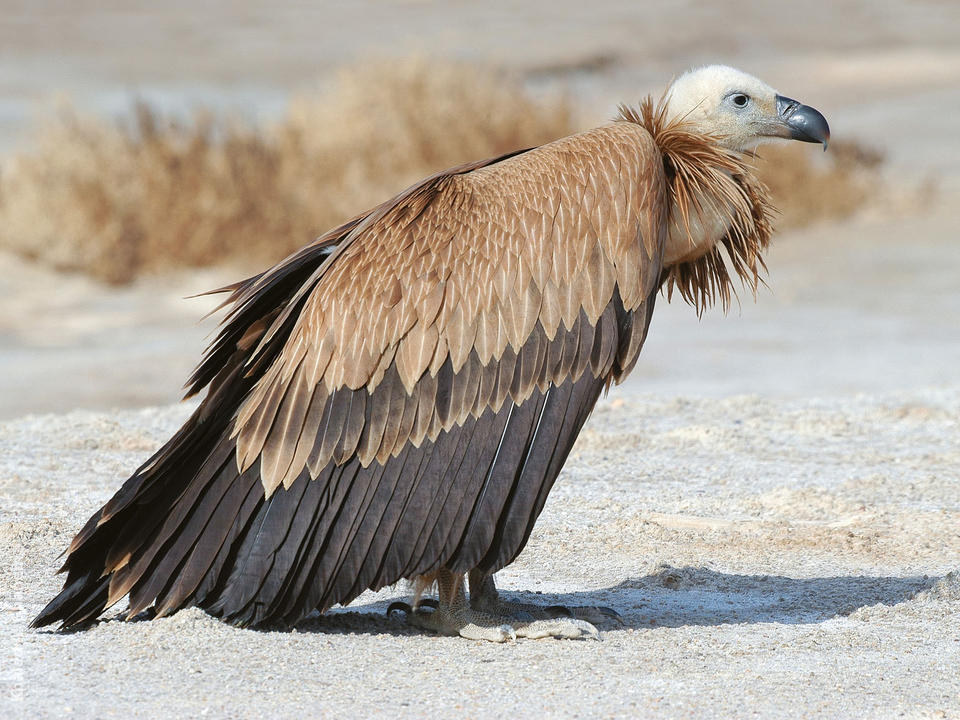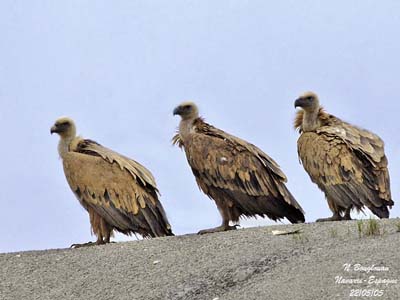Eurasian Griffon Bird Details
Gyps fulvus
Eurasian Griffon,Griffon Vulture;
Griffon Gidh
Carl Ludwig von Hablitz,1783
Accipitriformes (HAWKS, EAGLES and KITES)
Accipitridae
Gyps
Spain, France, Italy, Greece, Turkey, Israel, and parts of North Africa such as Morocco and Algeria.
Appearance :
Adults are mostly pale brown with a white underbelly and a darker, almost blackish head and neck. They have a distinctive ruff of feathers around their neck and broad, powerful wings.
Behaviour :
Highly social and often seen in large groups or colonies. They are known for their soaring flight, utilizing thermals to glide for hours. Typically breed in colonies on cliffs or mountainous regions. They have long-term pair bonds.
Habitat :
Rocky cliffs, mountainous regions, and open grasslands. They are often found in rugged terrains where they can nest in high, inaccessible areas.
Diet :
Primarily scavengers, feeding mainly on carrion. They play an important ecological role by cleaning up dead animal carcasses.
Conservation Status :
Least Concern
Distribution :
Found across southern and eastern Europe, the Middle East, and parts of North Africa.
Population Size :
Between 40,000 and 50,000 individuals.
Life Span :
Live up to 20 years, with some individuals reaching up to 30 years in captivity.
Body And Tarsus:
- Body: Robust and large with a broad wingspan. The body is mainly covered in light brown feathers, with darker tones on the head and neck.
- Tarsus Length: Approximately 10–13 cm (4–5 in). The tarsus is relatively long and strong, adapted for perching and walking on rugged terrain.
Head And Bill :
- Head Size and Shape: Large, with a relatively small head compared to the body. The head is covered in short, fine feathers that give it a somewhat bald appearance, with a darker color than the rest of the body.
- Bill: Strong and hooked, adapted for tearing flesh from carrion.
- Bill Length: Approximately 5–7 cm (2–2.8 in).
Length :
93–105 cm (37–41 in) from beak to tail.
Neck :
The neck is moderately long and covered with a ruff of feathers. It is quite flexible, allowing the bird to reach its food and manage its large head.
Size :
The Eurasian Griffon is a large vulture with a robust build and a significant wingspan. Males and females are similar in size, though males are often slightly larger.
Tail Details :
- Tail: The tail is broad and wedge-shaped, providing stability during flight.
- Tail Length: Approximately 30–35 cm (12–14 in).
Weight :
Typically ranges from 6.5 to 10.5 kg (14–23 lbs).
Wing :
The wings are broad and long with a slightly rounded tip, adapted for soaring. They have a wide wingspan and are designed for efficient gliding and soaring.
Wing Span :
230–270 cm (91–106 in).
Facial Feature :
The Eurasian Griffon has a distinct, somewhat bald head with a characteristic ruff of feathers around the neck. The face is pale and often appears wrinkled, with a strong, hooked beak.
Nest Details :
- Nest: Large and bulky, often located on high cliffs or in rugged terrain to provide safety from predators. The nest is made of sticks, branches, and other available materials.
- Nest Made Up of: The nest is constructed from a variety of materials, including sticks, twigs, branches, and sometimes leaves and feathers. It is often lined with softer materials like grass or moss for added comfort.
Breeding Season :
Typically from late winter to early summer.
Nesting Season :
Generally occurs from March to July.
Egg Color :
Typically pale or off-white, sometimes with small brown speckles.
Egg Length :
Approximately 7.5–8.5 cm (3–3.3 in).
Egg Width and Weight :
- Egg Width: About 6–7 cm (2.4–2.8 in).
- Egg Weight: Typically around 180–200 grams (6.3–7.1 oz).
Clutch Size :
Usually 1 to 2 eggs per breeding attempt.
No. of Broods :
Raises only one brood per breeding season.
Incubation Period :
Approximately 50–55 days.
Nestling Period :
Around 4 to 5 months of age.
Vocalization :
The vocalizations are generally soft and somewhat hoarse. They use a range of sounds including grunts, croaks, and whines.
Sex Demorphism :
Males are generally slightly larger and heavier than females.
Migration Details :
- Migration Pattern: Eurasian Griffons are largely resident birds, meaning they do not migrate long distances. However, some populations in northern areas may undertake partial migrations or dispersal movements in response to seasonal changes or availability of food.
- Migration Period: Movements are typically seen during late autumn and early spring, though these are more accurately described as local movements rather than true migration.








